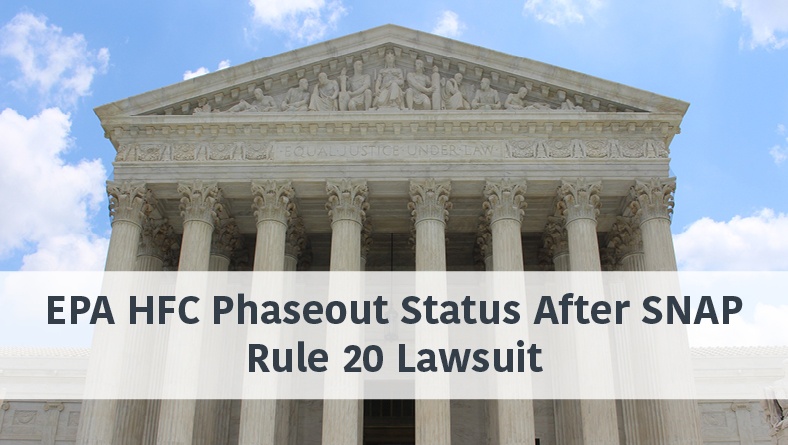
Trakref
Managing Environmental Compliance as an HVAC/R Pro

Effective HVAC/R and environmental compliance has always been about accuracy. It sounds simple, but it’s easier said than done. Precision isn’t achievable without an environmental compliance program that’s both intentional in daily operations and driven by a clear vision of compliance issues — with a full understanding of the complex array of regulations and requirements that are always changing.
Some of the biggest threats to your HVAC/R and environmental compliance program will indeed be attachments to the past. Pushback from comfortably old-fashioned leadership, reliance on obsolete HVAC/R systems and law, and archaic record-keeping methods can all present major obstacles to successful HVAC/R compliance.
HVAC/R Compliance
How much does a careful, precise “dot the i’s and cross the t’s” approach to HVAC and refrigerant tracking and compliance really matter? Will this extra effort please the Environmental Protection Agency and improve your environmental quality? Is accuracy worth the extra effort?
The answer is a resounding yes.
Compliance Impacts Climate Change
As we start 2022, owners and operators are now responsible for compliance reporting for energy use, refrigerant emissions, and HVAC/R maintenance, what’s driving this is the real impact that HVAC/R systems have on the atmosphere of the planet we all share. The recent three-day NEEP 2021 Summit highlighted this issue, including that 30% of all the Northeast’s total carbon emissions come from buildings. NEEP considers it important to reduce emissions from the built environment and work together on ozone depletion solutions.
Compliance Saves You Money
Compliance regulations and ESG performance matters for your bottom line, too. Effective HVAC/R compliance reporting enables your firm to save vast sums of money with more informed and efficient energy management (alongside these best practices). It also improves your image and opportunities in the market. Investors and banks, according to Harvard Business Review, are more willing to open the coffers and offer capital investments or loans to companies with a strong performance in ESG reports. Think of compliance as just showing up, and ESG reporting as your grade for how well you did once you did show up.
A Modern Solution Is Needed
Achieving perfect HVAC/R compliance isn’t easy. The reality on the ground is a 25% average annual leak rate for harmful refrigerants across all industries — well above regulatory goals. Coupled with a patchwork of regulations and an urgent push for tricky refrigerant phase downs (the law calls for an 85% reduction by 2036), the truth is that the data captured on the traditional invoice is not enough. You will need a smart, digital option to eliminate paper-based hassles.
HFC Refrigerants and Environmental Compliance
Over the next 15 years, a central focus of HVAC/R compliance will be the drawdown of HFC refrigerants. A major shift in HFC refrigerant policy occurred on September 23, 2021, when EPA Administrator Regan signed the final rule “Phasedown of Hydrofluorocarbons: Establishing the Allowance Allocation and Trading Program under the AIM Act.”
This rule established a comprehensive program to cap and phase down HFC production and consumption by 85% by 2036.
HFC and Environmental Regulations
Some examples of new HFC regulations include:
- The AIM Act, which sets out to grant the EPA the authority to control and manage HFC refrigerant through phasing down the production and consumption of HFCs, managing HFCs, and facilitating the transition to next-generation technologies.
- SNAP Rules 20 & 21, which enacted new regulatory requirements, including bans on certain HFC refrigerants in end-uses from air-conditioning to refrigeration.
- A new California Refrigerant Recovery, Recycle, and Reuse (R4) program regulation, which came into effect in 2021, as an amendment to the HFC regulation.
Asset-Centric Refrigerant Management
With the next refrigerant transition firmly underway — and the third in the past thirty years — in order to achieve compliance it’s a critical time to re-examine your approach to asset management. Most compliance programs are cylinder-based or invoice-based, making it impossible to measure the impact on assets, which is what environmental regulations expect and is needed for ESG reporting.
The most common asset management challenges faced by facilities are related to compliance, energy & maintenance, and asset value & scope. An asset-centric approach solves for these pain points and ensures optimal compliance and efficiency outcomes. Essentially, everything should be treated as an asset and have an identity within your tracking system.
The best way to accommodate this approach is with a logic-driven, structured workflow system, like Trakref, that tracks and controls how refrigerants are added, extracted, and transferred.
Energy Management
Refrigerant leaks result in a 1-1 leak to energy consumption impact. Five percent of a leak increase results in energy-related to HVAC/R going up 5%. Leak prevention will lead to energy savings. The first step you can take to better manage your building’s energy is to benchmark. This means to measure and compare your expenditures and efficiency to similar buildings, historical data on your usage, or a target performance level.
Excellent performance can save energy (and money) as well if you are in a certain industry you can earn you important recognitions. GreenChill certification, for example, is a prestigious high watermark for organizations in the supermarket industry, achieved via strong energy performance.
Your personalized benchmarking plan, according to Energy.gov, should spring from a framework that falls roughly into these 11 steps:
- Establish the goal for benchmarking
- Secure buy-in from leadership
- Build a benchmarking team
- Identify output metrics
- Identify data inputs
- Select a benchmarking tool
- Determine the collection method
- Consider a data verification process
- Evaluate analysis techniques
- Communicate the plan
- Plan for change
ESG Reporting
The methods that companies use to handle ESG reporting — and the regulations that govern them — have changed drastically in the past decade as environmental sustainability initiatives become popular.
The now-critical concept of Double Materiality, for example, was introduced by the EU Commission as a part of the 2019 Non-Binding Guidelines on Non-Financial Reporting Update (NFRD). This concept acknowledges that ESG topics can be “material” in terms of either financial or climate impacts — or both. It also acknowledges that ESG issues represent a combination of risks and opportunities for the company and for the environment.
ESG reporting is also becoming more mainstream. It used to be relegated to the world of idealists interested in a company’s environmental footprint. The information contained in the reports was considered a niche interest that very few stakeholders care about.
As time has gone on, though, more stakeholders care about corporate sustainability. Customers want to know that the companies they support have similar ideals to them, and a new generation of investors are interested in seeing how a company is following sustainability regulations.
For example, in a report from Morgan Stanley, “ESG and the Sustainability of Competitive Advantage,” the writers note that ESG is growing in importance in whether they choose to invest in a business: “Our ESG analysis focuses on a company’s ability to sustain competitive advantage over the long term. In considering candidates for our portfolios, we assess companies’ ESG oriented strengths and vulnerabilities across several dimensions.”
Since refrigerants are a top contributor to climate change, we think that ESG reports should include information about them, including how your company is following refrigerant regulations put forth in new laws. Trakref can help you compile this information and ensure you report accurate information.
Ensure You Have Documentation For Everything
Documentation is important for a number of reason.
First of all, you need it for ESG reporting. In order to properly report on your company’s use of refrigerants and develop the best report possible, you’ll need to have a paper trail answering sustainability audit questions. You’ll need to show how you maintain your current equipment, leak rates, and how you’re planning to upgrade equipment to be more environmentally friendly. Showing the environmental health of your company is crucial in these reports, and documents on refrigeration will be important.
Second, documents are important to maintain good relations with agencies including the EPA. Their laws and regulations tend to look to make sure that you are documenting activities regularly and fine people when they are not – fines don’t always come from leak rates. To make sure your company finds safety from fines, make sure you are always documenting.
Refrigerant Tracking Software
How do you make sure you’re doing your best documenting on environmental-related HVACR policies? You need to have a great tool. That’s where Trakref comes in.
Facility managers don’t have the time to invest in learning complicated software and sorting through HVACR regulations by the hundreds. The industry still runs heavily on paper and Excel simply because it always has.
At Trakref, we understand — running facilities are part of our DNA. We’ve been doing this work for 25+ years, and during that time, we’ve come to understand the relationship between following process and having an easy-to-use tool. What’s needed to improve HVACR, energy and ESG is a tool that’s:
- Simple to use
- Built to streamline the workflow
- Appealing to technicians and executives alike
- Comprehensive in scope (energy, refrigerants, financials, equipment, corporate performance)
- Effective for compliance, tracking, and reporting
- A real solution to the challenges you face
Trakref saves time and eliminates the guesswork for the entire team. Our patented cloud-based refrigerant system consists of individual solutions that all work together.
Trakref also makes it easy for training your team. The quality of our software is better than using spreadsheets or paper logs. With easy-to-use workflows, it’s easy to get your team up-to-speed on the training that they need to use the software. That way you’re not losing entire days that could be out in the field on training for complicated functions. Trakref will walk you through regulations and what you need to do for services so everyone is working efficiently and following procedures. With little training needed, you’ll be on your way to better refrigerant management compliance in very little time.
Conclusion: Refrigerant Geeks Unite
As a software corporation and environmental software provider, we’ve helped firms complete thousands of successful audits and track hundreds of millions of pounds of gas. It’s time to truly operationalize ESG efforts with regulatory compliance software, environmental compliance calendar software, and an app designed for the front lines. Every leak you prevent from slipping through the cracks reduces energy costs and regulatory risks while saving money.



